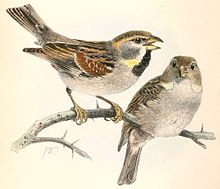Moab Sparrow
| Moab Sparrow | ||||||||||||
|---|---|---|---|---|---|---|---|---|---|---|---|---|

Moab Sparrow ( Passer moabiticus ) |
||||||||||||
| Systematics | ||||||||||||
|
||||||||||||
| Scientific name | ||||||||||||
| Passer moabiticus | ||||||||||||
| Tristram , 1864 |
The Moabsperling ( Passer moabiticus ) is a songbird from the sparrow family .
description
The Moab Sparrow has a body length of 12 to 13 centimeters and is therefore slightly smaller than the House Sparrow . Like many representatives of the genus, the Moabsperling also shows a strong sexual dimorphism in terms of color. The crown, neck and cheeks of the male are dark gray in the magnificent dress. It shows a light stripe above the eyes, which is white in front of the eye and yellow-brownish behind the eye. The throat is black and framed by a light yellow stripe of beard that continues on the sides of the neck. The rest of the fuselage is a solid gray. The back shows strong black stripes on a reddish-brown background. The large and middle arm covers are rust-brown and contrast strikingly with the otherwise predominantly black wing. The eastern breed P. m. yatii is more sand-colored, and the male is tinged with yellow underneath.
The female looks very similar to a female house sparrow, but is generally sand-colored and without gray tones and more contrasting in color. The head is unmarked pale brown except for a broad, light brown stripe over the eyes that begins behind the eye, the back is streaked with black on a sandy-brown background and the body is pale whitish-brown.
Vocalizations
The Reviergesang consists of sequenced, variable, fast or slow repeated calls like "trirp-trirp-trirp" or "chilp-tschrilp-tschrirp". The chirping song is reminiscent of that of a house or willow sparrow , but is less powerful. The flight call is a high chi-huit .
distribution and habitat
The breeding area of the species is strongly disjoint and extends over arid areas from southeast Turkey and Israel to Iraq , Iran to western Afghanistan . The species may have become extinct in Cyprus . Depending on the population , the Moabsperling is a resident , nomadic or migratory bird ; Migration behavior and winter quarters of many populations have so far only been insufficiently researched. The eastern breed is known to winter in Pakistan , but the wintering areas of the remaining Moab Sparrows are largely unclear. Swarms of the more westerly common nominate form have been observed further south in the Middle East in winter .
The species breeds in tree and bush vegetation near water. The vegetation in the breeding habitats mostly consists of tamarisks and similar trees and bushes bound to moist areas.
Reproduction
The Moab Sparrow nests in colonies. The nest is created in dead branches of tamarisks or similar trees. It is very large and complex to adapt to daytime temperatures of up to 45 ° C. It is built from twigs, is 25 to 35 cm in diameter and weighs up to 1 kg. An S-shaped tunnel leads from above to the softly padded nest hollow in the lower part of the nest. The clutch consists of four to seven eggs. It is incubated almost exclusively by the female. The female leaves the nest about six times an hour during the day; at air temperatures of more than 39 ° C, the female will sometimes stand at the nest entrance and pant.
nutrition
Like other sparrows, the species feeds primarily on seeds.
literature
- Lars Svensson , Peter J. Grant, Killian Mullarney, Dan Zetterström: The new cosmos bird guide. Kosmos, Stuttgart 1999, ISBN 3-440-07720-9 .
- Y. Yom-Tov, A. Ar and H. Mendelssohn: Incubation behavior of the Dead Sea Sparrow . Condor 80; 1978: pp. 340-343. View: [1]
Web links
- Age, Sex and Season related Biometrics of the Dead Sea Sparrow Passer moabiticus (PDF, Engl .; 204 kB)
- Passer moabiticus in the endangered Red List species the IUCN 2009. Posted by: BirdLife International, 2008. Accessed on March 19 of 2010.
- Photos of Passer moabiticus in the Oriental Bird Club image database , accessed on March 18, 2010

